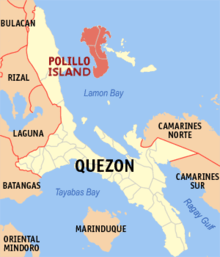Polillo Island
|
Aerial view of Polillo Island | |
.svg.png) Polillo Island Location within the Philippines .svg.png) Polillo Island Polillo Island (Philippines) | |
| Geography | |
|---|---|
| Location | Lamon Bay |
| Coordinates | 14°50′34″N 121°55′45″E / 14.84278°N 121.92917°ECoordinates: 14°50′34″N 121°55′45″E / 14.84278°N 121.92917°E |
| Archipelago | Polillo Islands |
| Adjacent bodies of water | |
| Area | 628.9 km2 (242.8 sq mi)[1] |
| Highest elevation | 350 m (1,150 ft) |
| Highest point | Mount Malulod |
| Administration | |
|
Philippines | |
| Region | CALABARZON |
| Province | Quezon |
| Municipalities | |
| Largest municipality | Polillo (pop. 28,125) |
| Demographics | |
| Population | 64,802 (2010)[2] |
| Pop. density | 103.0 /km2 (266.8 /sq mi) |
Polillo (Tagalog pronunciation: [poˈliʎo̞]) is an island in the northeastern region of the Philippine archipelago. It is separated from Luzon Island by the Polillo Strait and forms the northern side of Lamon Bay.

The island itself is subdivided across three municipalities. The municipality of Polillo covers the southern portion of the island, while the northeastern part is administered by the municipality of Burdeos. The northwest is within the jurisdiction of the municipality of Panukulan. The island is also home to the Butaan lizard, a vulnerable relative of the Komodo dragon.[3]
As of the 2010 Philippine Census, the island is home to 64,802 individuals.[2]
In the mid-16th century, Spaniards came to the island and there they built a chapel. They took charge of the management of the island and many changes and development they brought there upon their times.
See also
References
- ↑ "Islands by Land Area". Island Directory Tables. United Nations Environment Programme. Retrieved 4 March 2013.
- 1 2 "Total Population by Province, City, Municipality and Barangay: as of May 1, 2010" (PDF). 2010 Census of Population and Housing. National Statistics Office. Archived from the original (PDF) on 29 October 2013. Retrieved 27 November 2013.
- ↑ Sy, E.; Afuang, L.; Duya, M.R. & Diesmos, M. (2009). "Varanus olivaceus". The IUCN Red List of Threatened Species. IUCN. 2009: e.T22888A9396856. doi:10.2305/IUCN.UK.2009-2.RLTS.T22888A9396856.en. Retrieved 23 December 2017.
External links

- Philippine Standard Geographic Code
- Philippine Census Information
- Wildlife and Conservation in the Polillo Islands